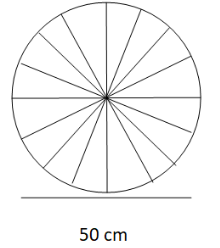
A wheel bicycle has inner diameter
A.
B.
C.
D.
Answer
410.4k+ views
Hint: We have been given a wheel whose diameter and thickness is given along with the revolution it makes in a certain time. For finding what the speed of the wheel is, firstly we will find the distance travelled by the wheel in one round. Then we will find the revolution made in one second. Finally by using the speed formula we will get our desired answer.
Complete step by step answer:
A wheel is given with below dimensions:
Diameter
Thickness
So we can draw the wheel as follows:

Now firstly we will find the Distance travelled by the wheel in one round.
As we know distance of a circular shape is calculated as follows:
Distance
Where
Formula for finding radius of wheel is given as:
Radius
Where
Substitute values from equation (1) and (2) in equation (4) we get,
So we get the radius as:
Substitute the above value in equation (3) we get,
On solving further we get,
As we know
Next it is given that In
Therefore speed of the bicycle will be,
On solving we get,
Speed
Hence option B is correct.
Note: In this type of question it is necessary to visualize the shape of the object given. As we have been provided the thickness of it as well so it means the object is in three-dimension and hence it becomes necessary to find the radius of it accordingly. Speed of any object is the division between the distance travelled by it and the time taken to travel that distance.
Complete step by step answer:
A wheel is given with below dimensions:
Diameter
Thickness
So we can draw the wheel as follows:

Now firstly we will find the Distance travelled by the wheel in one round.
As we know distance of a circular shape is calculated as follows:
Distance
Where
Formula for finding radius of wheel is given as:
Radius
Where
Substitute values from equation (1) and (2) in equation (4) we get,
So we get the radius as:
Substitute the above value in equation (3) we get,
On solving further we get,
As we know
Next it is given that In
Therefore speed of the bicycle will be,
On solving we get,
Speed
Hence option B is correct.
Note: In this type of question it is necessary to visualize the shape of the object given. As we have been provided the thickness of it as well so it means the object is in three-dimension and hence it becomes necessary to find the radius of it accordingly. Speed of any object is the division between the distance travelled by it and the time taken to travel that distance.
Latest Vedantu courses for you
Grade 11 Science PCM | CBSE | SCHOOL | English
CBSE (2025-26)
School Full course for CBSE students
₹41,848 per year
Recently Updated Pages
Express the following as a fraction and simplify a class 7 maths CBSE

The length and width of a rectangle are in ratio of class 7 maths CBSE

The ratio of the income to the expenditure of a family class 7 maths CBSE

How do you write 025 million in scientific notatio class 7 maths CBSE

How do you convert 295 meters per second to kilometers class 7 maths CBSE

Write the following in Roman numerals 25819 class 7 maths CBSE

Trending doubts
State and prove Bernoullis theorem class 11 physics CBSE

What are Quantum numbers Explain the quantum number class 11 chemistry CBSE

Write the differences between monocot plants and dicot class 11 biology CBSE

Who built the Grand Trunk Road AChandragupta Maurya class 11 social science CBSE

1 ton equals to A 100 kg B 1000 kg C 10 kg D 10000 class 11 physics CBSE

State the laws of reflection of light




